Weavie Wonder
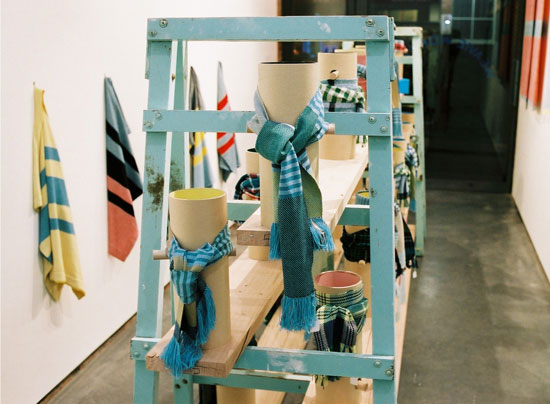
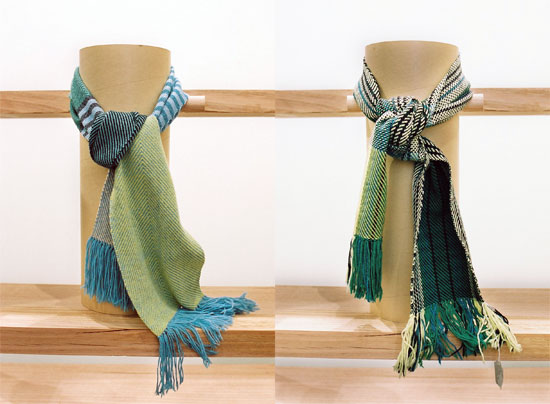
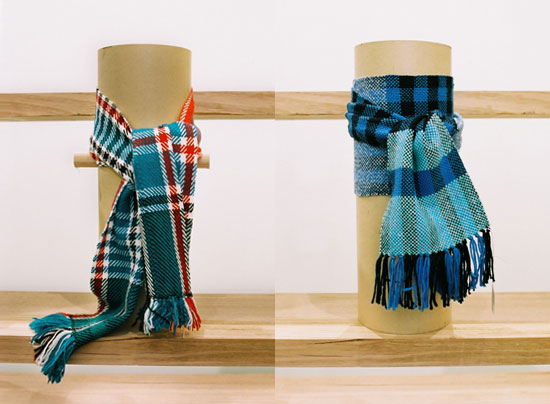
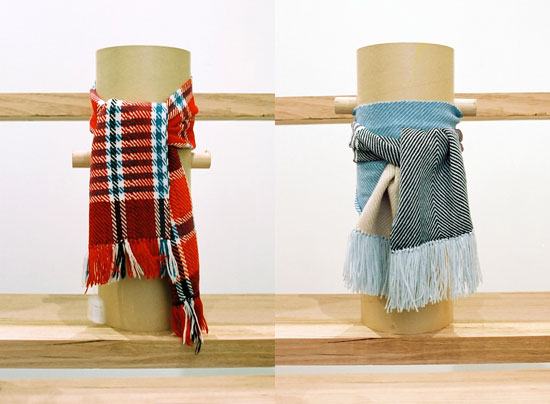
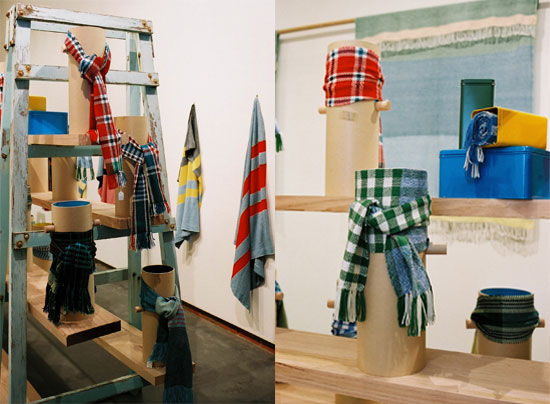
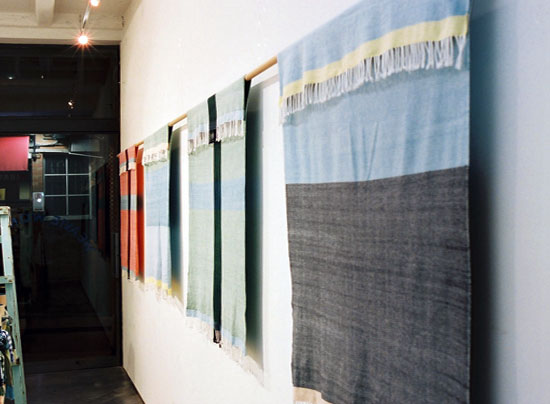
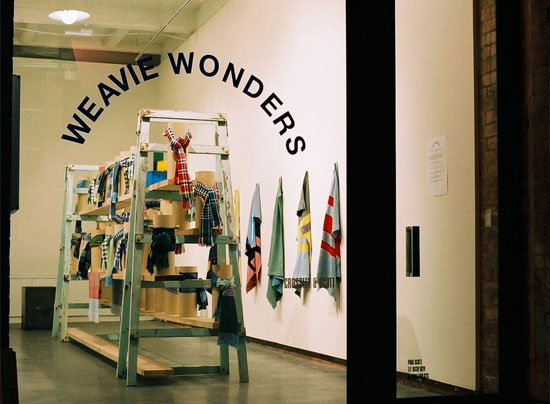 Words: Max Olijnyk Images: Christopher Day
Words: Max Olijnyk Images: Christopher Day
Sunday Ganim’s work makes you feel good. Her hand woven scarves and blankets are kaleidoscopic visions of colour and unrestrained imagination, but most importantly, are soft on the skin and warm you up on a cold day. Sunday brings a fresh, unconventional energy to a medium steeped in tradition, while embracing the elements that attracted her to it in the first place. Following her recent exhibition Weavie Wonders, the Melbourne artist had a yarn with Max Olijnyk.
Max Olijnyk: So, how did you get started on the weaving? What attracted you to it in the first place?
Sunday Ganim: My mum used to do it and make these incredible things and I showed an interest, so she organised for me to do a course and went from there…
MO: What was the first thing you made? How has your work progressed since then?
SG: I think is was a really basic bag but then I started making scarves pretty soon after – I used to make them for friends birthdays – I really enjoyed putting different colours together, especially mixing colours that didn’t necessarily go together – completely unstructured and seeing how they would turn out, I guess.
MO: I know you work with some master weavers now. How did that come about? Can you tell me about them? I bet they’re interesting characters.
SG: Well my mum actually knew a lot of them through an organisation called the Victorian Spinners and Weavers Association. They’re in Carlton and are really great, an association of mainly older ladies who get together and weave things and swap ideas etc. They all have a pretty vast amount of knowledge between them and are so eager to help you out it’s amazing – they’re very encouraging.
I came to know a lady who’s a master weaver and has woven all her life. She lives with her husband in one of the most interesting and eclectic houses I have ever seen. She’s super crafty and he’s an ex-photographer who’s now really into aerodynamics, engines and physics. Their house is filled to the brim with all kinds of great stuff – books stacked to the ceilings, and they each have a couple of ‘studio’ kind of rooms. His is filled with thousands of pieces of technical equipment and hers is a kind of craft emporium with books stacked up to the ceiling and all kinds of crafty tools and knick knacks – it’s great.
He’s really into cars and can fix pretty much anything. He bought a Porsche a long time ago and she wove a fabric in tartan that they hand stitched into the seats of the car to personalise the Porsche! And it’s so perfect it looks like it was made that way.
Anyway, she’s a wonderful lady with a soul of gold who can weave anything so perfectly that it looks as if a machine has made it – amazing.
MO: How do you source your materials? What sets one yarn apart from another?
SG: Originally I was using this yarn from a place in South Melbourne called the Victorian Tapestry Workshop. They have the most amazing coloured yarn. It’s wild. Standing in their showroom looking at all the colours is pretty exciting. Anyway, that yarn is used to weave gigantic tapestries and is a bit scratchy and is not so soft for people’s necks so I went on the search for super soft yarn in great colours, which I found surprisingly hard.
As times have gotten tough and a lot of manufacturing is now happening offshore in places like China, the Australian knitwear and wool industry has shrunk substantially since the 80s. I couldn’t find the quality of wool I was after in a broad enough colour range in Australia, so I ended up sourcing a yarn from Italy that was 80% Australian Superfine Merino Wool and 20% Cashmere – which seemed crazy to me – to be buying back Australian wool from Italy, but that’s the reality of manufacturing knitwear in Australia on a small scale.
MO: What’s the process in designing and making your work? Is it quite meticulously planned, or is it more spontaneous? I know from experience it’s sometimes difficult to keep that creative energy going when you have to manufacture something with machines.
SG: This is pretty naive, but I really like colours – mostly pretty random colour selections that you find almost by accident. So usually in the months leading up to making a bunch of scarves, I’ll take photos and collect things that I see where the colour combinations are great. My camera and pockets get filled up with photos and scraps of everything and anything – heaps of stuff really – things from magazines and the internet, details of houses, snapshots from cooking, things in the park or street, friends houses etc. Then I start to get good feelings from certain colours and then they become the basis in my head of what I want to do in the scarves.
I usually want to plan everything but it never works out that way- the best stuff usually comes when I am relaxed and just going with the flow of what’s happening at the time.
The laborious process of weaving can be really frustrating as it makes it hard to quickly change your ideas if it’s not working out, but it can also be fantastic as it will make you stick with the colours you have chosen till you get them to sing along together. Get the colours zapping away with each other.
MO: Most artwork isn’t intended to be touched or interacted with besides being admired from afar. Yours is quite the opposite. Also, things like scarves are things that are often quite boring or not really thought of beyond their obvious function. Your work sits somewhere in between. How do you define your work, if that’s possible? What does it mean to you?
SG: I don’t think of them as art Max, I just see them really as a way for myself to be able to have access to putting together a whole bunch of colours in a way that can be surprising – that people can wrap around themselves, and each time it’s a little different. I think that hand making things for people is also really special and hopefully gives them a feeling of love and warmth every time they wear it.
MO: But it’s not just scarves, is it. Tell us about the blankets! Those things are amazing!
SG: No! There are blankets too! I am really excited about them. They only came about this year you can put them on your couch or bed or wrap yourself up in the biggest scarf ever – they’re made to order and again, can be really personal which I think is important.
MO: What other work have you exhibited apart from Weavie Wonders? How did WW come about?
SG: I did another scarf exhibition on a much smaller scale last year called Scarf-Ace. Weavie Wonders was originally going to be called Neck Up but then the blankets came along, and then a friend came up with the stellar name Weavie Wonders!
MO: Are you ever surprised at people’s response to your work? Do people bond with certain items straight away, then maybe sometimes you might create something with someone in mind, and they don’t feel it the same way?
SG: Yeah, I’ve been commissioned to make custom made scarves for people a bunch of times, which I enjoy. They give me a few of their favourite colours and usually specify how mixed up they want the design. Mostly people seem really happy when they receive them. On the whole it’s great because in solidifies the fact that everyone’s tastes are really different – what one person might hate, another will fall in love with.
MO: Tell me a bit about the installation for Weavie Wonders. Was all that wood in there already?
SG: Oh that all came together in the final hour. I originally wanted to hang all the scarves from bunches of helium balloons so that they were floating in the space like parachutes – but after a few tests we realised it wasn’t going to happen. The painter’s ladders actually came from Irene’s place and I was lucky enough to get a massive favour from the guys at my hardware shop to borrow the wood for a few days. Then a handful of lovely people came over and helped me pull it all together a few days before the opening.
MO: The coloured tin boxes are a nice touch. What was the thinking there?
SG: I think it’s good to mix up surfaces – the scarves are woollen and tactile and tin is the opposite – shiny and super bright. I got them powder coated in Preston and they turned out great, so you’ll be seeing them again soon I hope.
MO: Do you ever get tired of the weaving medium? Is it meditative? Do you work in other mediums?
SG: Hell yes! But I think it’s like anything that you do for a while you go through periods of wanting to change just to keep it interesting. For me it’s meditative, people say it’s a kind of therapy, which I guess is true. I’m just getting over having chronic fatigue for the last year or so and it has helped out a lot in that respect I think.
MO: Your studio is a mess, Sunday! So is mine! So is yours always chaotic, or is it just post-show opening craziness in there right now?
SG: Oh it’s soooo messy. Usually the mess builds up – then you have a cleaning session so you can think a little clearer and then the build up starts again!
MO: What other artists are you into at the moment? What other stuff are you into at the moment? What are you working on next?
SG: I bought a kaleidoscope a few months ago and have begun making my own ones and taking photos of colours with that which is really interesting. I have a few ideas kicking around to build some light boxes with moving parts inside them similar to old pre-cinema techniques, that I’m about to start. I was making a lot of pop up books out of old magazines for a while last year which I haven’t done since, so they’re back on the agenda too, possibly with a different function than the ol’ book. And I just did a little course to learn how to mould things with resins and the like, which I will try to get a grasp of in the next few months and see what happens…
Then of course more Weavie Wonders to come – scarves, blankets, baby blankets and possibly knitted ties – keep a look out!
Sunday Ganim
Next Article



